2013年合肥工业大学物理化学初试真题
- 格式:doc
- 大小:1.73 MB
- 文档页数:3
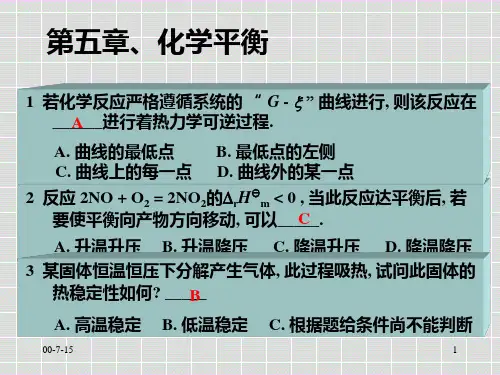
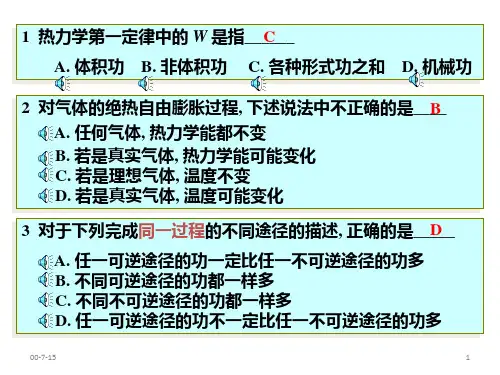
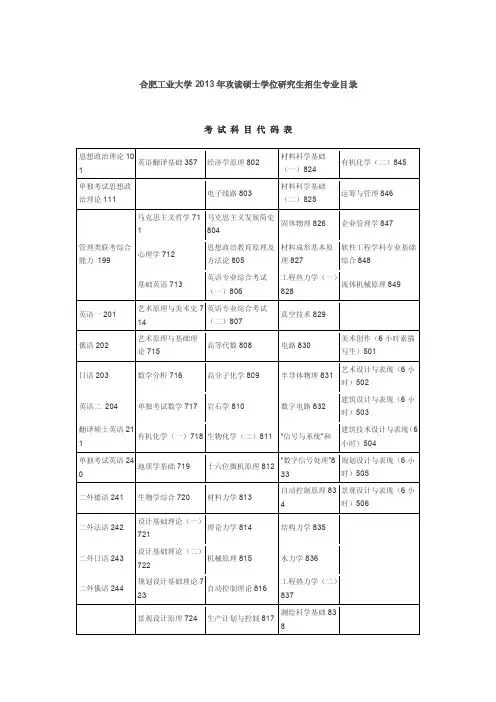
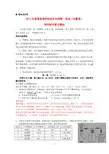
绝密★启用前2013年普通高等学校招生全国统一考试(安徽卷)理科综合能力测试本试卷分为第I卷(选择题)和第II卷(非选择题),第I卷第1页至第5页,第II卷第6页至第12页。
全卷满分300分。
考生注意事项:1.答题前,务必在试题卷、答题卡规定的地方填写自己的姓名、座位号,并认真核对答题卡上所粘贴的条形码中的姓名、座位号与本人姓名、座位号是否一致。
务必在答题卡背面规定的地方填写姓名和座位号后两位。
2.答第I卷时,每小题选出答案后,用2B铅笔把答题卡上所对应题目的答案标号涂黑。
如需改动,用橡皮擦干净后,再选涂其他答案标号。
3.答第II卷时,必须使用0.5毫米的黑色墨水签字笔在答题卡上....书写,要求字体工整、笔迹清晰。
作图题可先用铅笔在答题卡的规定的位置绘出,确认后再用0.5毫米的黑色墨水签字笔描清楚。
必须在题号所指示的答题区域作答,超出答题区域书写的答案无效,在试题.................卷、草稿纸上答题无效。
...........4.考试结束后,务必将试题卷和答题卡一并上交。
第I卷(选择题共120分)本卷共20小题,每小题6分,共120分。
在每小题给出的四个选项中,只有一项是符合题目要求的。
以下数据可供解题时参考相对原子质量(原子量):H1 C12 N14 O16 Ai27 S32 Cl35.5 Ce140 Pb2077.我国科学家研制出一中催化剂,能在室温下高效催化空气中甲醛的氧化,其反应如下:HCHO+O2催化剂 CO2+H2O。
下列有关说法正确的是A.该反应为吸热反应 B.CO2分子中的化学键为非极性键C.HCHO分子中既含α键又含π键 D.没生成1.8gH2O消耗2.24L O2【答案】C【解析】A、该反应在室温下可以进行,故该反应为放热反应,错误;B、二氧化碳结构为O C O==,为极性键,错误;C、甲醛中,含有碳氧双键,故期中既含有σ键又含有π键,正确;D、氧气的体积,并没有标明状况,故不一定为2.24L,错误。

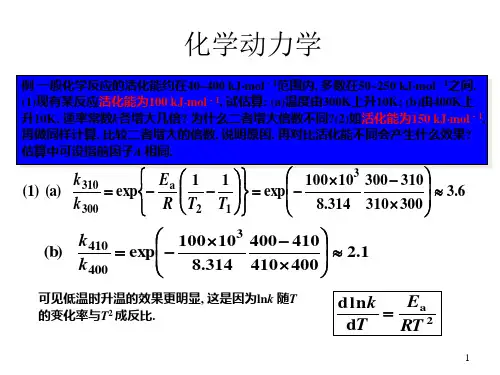
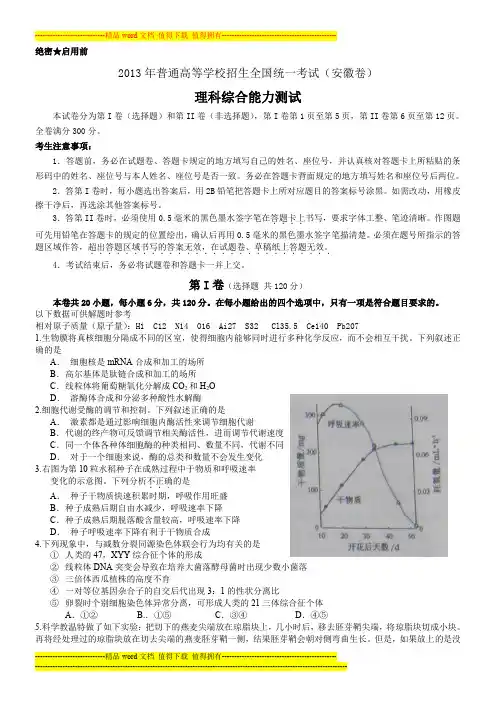
绝密★启用前2013年普通高等学校招生全国统一考试(安徽卷)理科综合能力测试本试卷分为第I卷(选择题)和第II卷(非选择题),第I卷第1页至第5页,第II卷第6页至第12页。
全卷满分300分。
考生注意事项:1.答题前,务必在试题卷、答题卡规定的地方填写自己的姓名、座位号,并认真核对答题卡上所粘贴的条形码中的姓名、座位号与本人姓名、座位号是否一致。
务必在答题卡背面规定的地方填写姓名和座位号后两位。
2.答第I卷时,每小题选出答案后,用2B铅笔把答题卡上所对应题目的答案标号涂黑。
如需改动,用橡皮擦干净后,再选涂其他答案标号。
3.答第II卷时,必须使用0.5毫米的黑色墨水签字笔在答题卡上....书写,要求字体工整、笔迹清晰。
作图题可先用铅笔在答题卡的规定的位置绘出,确认后再用0.5毫米的黑色墨水签字笔描清楚。
必须在题号所指示的答题区域作答,超出答题区域书写的答案无效,在试题卷、草稿纸上答题无效。
............................4.考试结束后,务必将试题卷和答题卡一并上交。
第I卷(选择题共120分)本卷共20小题,每小题6分,共120分。
在每小题给出的四个选项中,只有一项是符合题目要求的。
以下数据可供解题时参考相对原子质量(原子量):H1 C12 N14 O16 Ai27 S32 Cl35.5 Ce140 Pb2071.生物膜将真核细胞分隔成不同的区室,使得细胞内能够同时进行多种化学反应,而不会相互干扰。
下列叙述正确的是A.细胞核是mRNA合成和加工的场所B.高尔基体是肽链合成和加工的场所C.线粒体将葡萄糖氧化分解成CO2和H2OD.溶酶体合成和分泌多种酸性水解酶2.细胞代谢受酶的调节和控制。
下列叙述正确的是A.激素都是通过影响细胞内酶活性来调节细胞代谢B.代谢的终产物可反馈调节相关酶活性,进而调节代谢速度C.同一个体各种体细胞酶的种类相同、数量不同,代谢不同D.对于一个细胞来说,酶的总类和数量不会发生变化3.右图为第10粒水稻种子在成熟过程中于物质和呼吸速率变化的示意图。
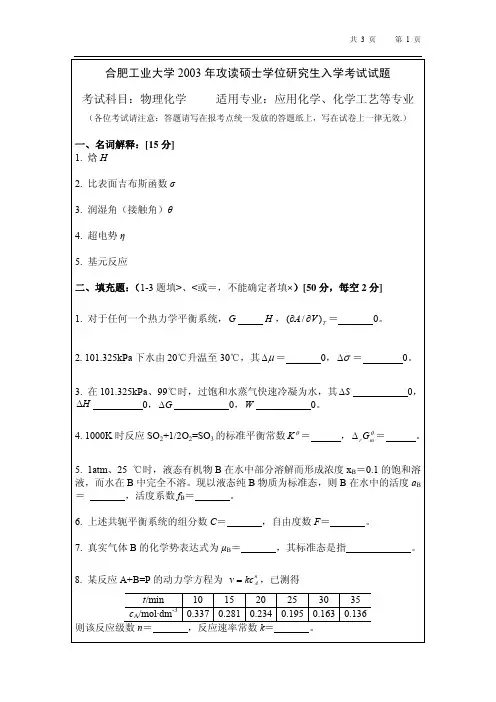
合肥工业大学2003年攻读硕士学位研究生入学考试试题 考试科目:物理化学 适用专业:应用化学、化学工艺等专业(各位考试请注意:答题请写在报考点统一发放的答题纸上,写在试卷上一律无效.)一、名词解释:[15分] 1. 焓H2. 比表面吉布斯函数σ3. 润湿角(接触角)θ4. 超电势η5. 基元反应二、填充题:(1-3题填>、<或=,不能确定者填×)[50分,每空2分]1. 对于任何一个热力学平衡系统,G H ,T V A )/(∂∂= 0。
2. 101.325kPa 下水由20℃升温至30℃,其μΔ= 0,σΔ= 0。
3. 在101.325kPa 、99℃时,过饱和水蒸气快速冷凝为水,其S Δ 0,H Δ 0,G Δ 0,W 0。
4. 1000K 时反应SO 2+1/2O 2=SO 3的标准平衡常数θK = ,θmr G Δ= 。
5. 1atm 、25 ℃时,液态有机物B 在水中部分溶解而形成浓度x B =0.1的饱和溶液,而水在B 中完全不溶。
现以液态纯B 物质为标准态,则B 在水中的活度a B = ,活度系数f B = 。
6. 上述共轭平衡系统的组分数C = ,自由度数F = 。
7. 真实气体B 的化学势表达式为μB = ,其标准态是指 。
8. 某反应A+B=P 的动力学方程为 nA kc v =,已测得t /min 10 15 20 25 30 35c A /mol·dm -3 0.3370.2810.2340.1950.1630.136则该反应级数n = ,反应速率常数k = 。
9. 固体A 对气体B 的吸附符合朗格谬尔理论,已知其吸附系数b =0.5kPa -1,则当覆盖率θ为1/2时B 的压力p B = kPa ,当B 的压力p B 为4kPa 时的覆盖率θ= 。
10. 对于0.01mol/kg 的CaCl 2水溶液,其离子强度I = 。
若已知r ±=0.724,则b ±= mol/kg ,a ±= 。
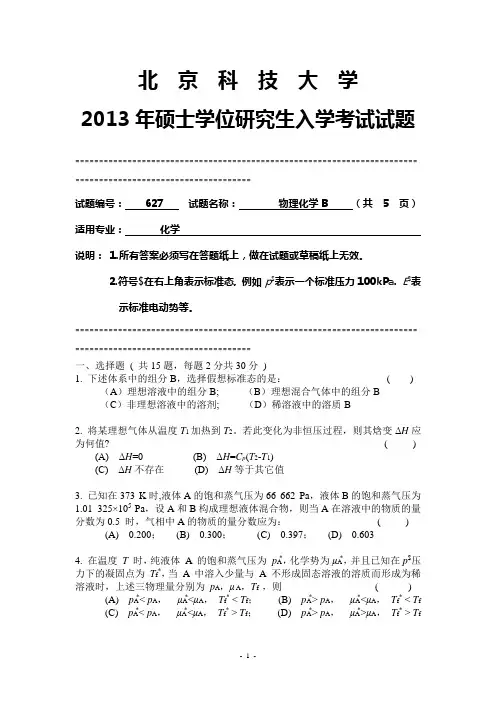
北京科技大学2013年硕士学位研究生入学考试试题============================================================================================================= 试题编号: 627 试题名称:物理化学B (共 5 页)适用专业:化学说明: 1.所有答案必须写在答题纸上,做在试题或草稿纸上无效。
2.符号$在右上角表示标准态, 例如p$表示一个标准压力100kPa. E$表示标准电动势等。
=============================================================================================================一、选择题( 共15题,每题2分共30分)1. 下述体系中的组分B,选择假想标准态的是:( )(A)理想溶液中的组分B; (B)理想混合气体中的组分B(C)非理想溶液中的溶剂; (D)稀溶液中的溶质B2. 将某理想气体从温度T1加热到T2。
若此变化为非恒压过程,则其焓变ΔH应为何值? ( )(A) ΔH=0 (B) ΔH=C p(T2-T1)(C) ΔH不存在(D) ΔH等于其它值3. 已知在373 K时,液体A的饱和蒸气压为66 662 Pa,液体B的饱和蒸气压为1.01 325×105 Pa,设A和B构成理想液体混合物,则当A在溶液中的物质的量分数为0.5 时,气相中A的物质的量分数应为:( )(A) 0.200;(B) 0.300;(C) 0.397;(D) 0.6034. 在温度T时,纯液体A 的饱和蒸气压为p A*,化学势为μA*,并且已知在p$压力下的凝固点为T f*,当 A 中溶入少量与 A 不形成固态溶液的溶质而形成为稀溶液时,上述三物理量分别为p A,μ A,T f ,则( )(A) p A*< p A, μA*<μA,T f* < T f;(B) p A*> p A, μA*<μA,T f* < T f(C) p A*< p A, μA*<μA,T f* > T f;(D) p A*> p A, μA*>μA,T f* > T f5. 有下述陈述(1) 溶液的化学势等于溶液中各组分的化学势之和(2) 对于纯组分,则化学势等于其摩尔Gibbs自由能(3) 理想溶液各组分在其全部浓度范围内服从Henry定律(4) 理想溶液各组分在其全部浓度范围内服从Raoult定律上述诸说法正确的是:( )(A) (1),(2);(B) (2),(3);(C) (2),(4);(D) (3),(4)6. 如图,在绝热盛水容器中,浸有电阻丝,通以电流一段时间,如以电阻丝为体系,则上述过程的Q 、W 和体系的ΔU 值的符号为: ( )(A) W = 0, Q < 0, ΔU < 0; (B) W < 0, Q < 0, ΔU > 0(C) W = 0, Q > 0, ΔU > 0; (D )W < 0, Q = 0, ΔU > 07. 节流过程中,下述说法正确的是 ( )(A )内能不变,压力减少; (B )焓不变,压力减少;(C )吉布斯自由能不变,压力不变;(D )焓不变,压力增加。

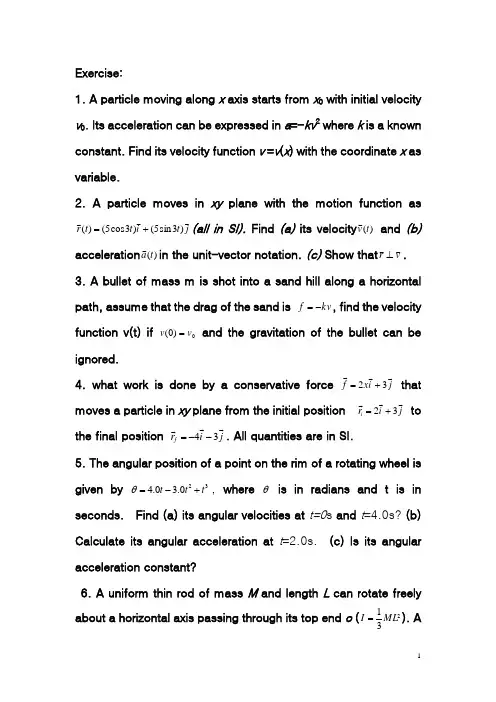
Exercise:1. A particle moving along x axis starts from x 0 with initial velocity v 0. Its acceleration can be expressed in a =-kv 2 where k is a known constant. Find its velocity function v =v (x ) with the coordinate x as variable.2. A particle moves in xy plane with the motion function asj t i t t r )3sin 5()3cos 5()(+=(all in SI). Find (a) its velocity )(t v and (b)acceleration )(t ain the unit-vector notation. (c) Show that v r ⊥. 3. A bullet of mass m is shot into a sand hill along a horizontal path, assume that the drag of the sand is kv f -=, find the velocity function v(t) if 0)0(v v = and the gravitation of the bullet can beignored.4. what work is done by a conservative force j i x f 32+= thatmoves a particle in xy plane from the initial position j i r i 32+= tothe final position j i r f 34--=. All quantities are in SI.5. The angular position of a point on the rim of a rotating wheel is given by 320.30.4t t t +-=θ, where θ is in radians and t is in seconds. Find (a) its angular velocities at t=0s and t =4.0s? (b) Calculate its angular acceleration at t =2.0s. (c) Is its angular acceleration constant?6. A uniform thin rod of mass M and length L can rotate freely about a horizontal axis passing through its top end o (231ML I =). Abullet of mass m penetrates the rod passing its center of mass when the rod is in vertical stationary. If the path of the bullet is horizontal with an initial speed v o before penetration and 20v after penetration . Show that (a) the angular velocity of the rod just after the penetration is MLmv 430=ω. (b) Find the maximum angular max θ the rod will swing upward after penetration.7. A 1.0g bullet is fired into a block (M=0.50kg) that is mounted on the end of a rod (L=0.60m). The rotational inertia of the rod alone about A is 206.0m kg ⋅. The block-rod-bullet system then rotates about a fixed axis at point A. Assume the block is small enough to treat as a particle on the end of the rod. Question: (a) What is the rotational inertia of the block-rod-bullet system about A? (b) If the angular speed of the system about A just after the bullet ’s impact is 4.5rad/s , What is the speed of the bullet just before the impact?8. A clock moves along the x axis at a speed of 0.800c and reads zero as it passes the origin. (a) Calculate the Lorentz factor γ between the rest frame S and the frame S* in which the clock is rest. (b) what time does the clock read as it passes x =180m ?9. What must be the momentum of a particle with mass m so that its total energy is 3 times rest energy?10. Ideal gas within a closed chamber undergoes the cycle shownthe Fig. Calculate Q net the net energy added to the gas as heat during one complete cycle.11. One mole of a monatomic ideal gas undergoes the cycle shown in the Fig. temperature at state A is 300K.(a). calculate the temperature of state B and C.(b). what is the change in internal energy of the gas between stateA and state B? (int E )(c). the work done by the gas of the whole cycle .(d). the net heat added to the gas during one complete cycle.12. The motion of the electrons in metals is similar to the motion of molecules in the ideal gases. Its distribution function of speed is not Maxwell ’s curve but given by.⎩⎨⎧=0)(2Av v pthe possible maximum speed v F is called Fermi speed. (a) plot the distribution curve qualitatively. (b) Express the coefficientA in terms of v F . (c) Find its average speed v avg .13. Two containers are at the same temperature. The first contains gas with pressure 1p , molecular mass 1m , and rmsspeed 1rms v . The second contains gas with pressure 12p , molecularmass 2m , and average speed 122rms avg v v =. Find the mass ratio21m m .14. In a quasi-static process of the ideal gas, dW =PdV and d E int =nC v dT . From the 1st law of thermodynamics show that the change of entropy i f v i fT T nC V V nR S ln ln +=∆ .Where n is the numberof moles, C v is the molar specific heat of the gas at constant volume, R is the ideal gas constant, (V i , T i ) and (V f , T f ) . are the initial and final volumes and temperatures respectively.15. It is found experimentally that the electric field in a certain region of Earth ’s atmosphere is directed vertically down. At an altitude of 300m the field is 60.0 N /C ; at an altitude of 200m , thefield is 100N /C . Find the net charge contained in a cube 100m on edge, with horizontal faces at altitudes of 200m and 300m . Neglect the curvature of Earth.16. An isolated sphere conductor of radius R with charge Q . (a) Find the energy U stored in the electric field in the vacuum outside the conductor. (b) If the space is filled with a uniform dielectrics of known r ε what is U * stored in the field outside the conductorthen?17. Charge is distributed uniformly throughout the volume of an infinitely long cylinder of radius R. (a) show that, at a distance r from the cylinder axis (r<R), r E 02ερ=, where ρis the volume charge density. (b) write the expression for E when r>R .18. A non-uniform but spherically symmetric distribution of charge has a volume density given as follow:⎩⎨⎧-=0)/1()(0R r r ρρwhere 0ρ is a positive constant, r is the distance to the symmetric center O and R is the radius of the charge distribution. Within the charge distribution (r < R ), show that (a) the charge contained in the co-center sphere of radius r is )34(31)(430r R r r q -=πρ, (b) Find the magnitude of electric field E (r ) within the charge (r < R ). (c) Find the maximum field E max =E (r *) and the value of r *.19. In some region of space, the electric potential is the following function of x,y and z: xy x V 22+=, where the potential is measured in volts and the distance in meter . Find the electric field at the point x=2m, y=2m . (express your answer in vector form)20. The Fig. shows a cross section of an isolated spherical metal shell of inner radius R 1 and outer radius R 2. A point charge q is located at a distance 21R from the center of the shell. If the shell is electrically neutral, (a) what are the induced charges (Q in , Q out ) on both surfaces of the shell? (b) Find the electric potential V(0) at the center O assume V (∞)=0.21. Two large metal plates of equal areaare parallel and closed to each other with charges Q A , Q B respectively. Ignore the fringing effects, find (a) the surface charge density on each side of both plates, (b) the electric field at p1, p 2 . (c) the electric potential A and B)。
物理化学考核题目及答案题目1题目:请解释什么是化学反应速率与速率常数,并给出它们的定义。
答案:化学反应速率是指单位时间内反应物消失或产物生成的数量。
速率常数是指在给定温度下,反应速率与反应物浓度之间的比例常数。
题目2题目:请解释活化能是什么,并给出它的定义。
答案:活化能是指在化学反应中使得反应发生所需的最小能量。
它是指反应物中分子碰撞的能量必须超过活化能才能形成反应物之间的活化复合物,从而使反应发生。
题目3题目:请解释反应速率的影响因素,并简要说明每个因素的作用。
答案:反应速率的影响因素有温度、浓度、催化剂和表面积四个。
温度的增加会增加反应颗粒的动力学能量,从而增加反应速率;浓度的增加会增加反应颗粒的碰撞频率,从而增加反应速率;催化剂通过提供新的反应路径,降低反应活化能,从而增加反应速率;表面积的增加会增加反应物与催化剂之间的接触面积,从而增加反应速率。
题目4题目:请解释速率方程式的含义,并给出一个具体的速率方程式的例子。
答案:速率方程式是指通过实验测定得出的反应速率与各个反应物浓度之间的关系。
一个具体的例子是二氧化氮与一氧化氮反应生成二氧化氮的反应速率方程式为:v = k[NO₂]²。
题目5题目:请解释动力学模型是什么,并简要说明动力学模型建立的过程。
答案:动力学模型是根据实验数据建立的描述化学反应速率与反应物浓度之间关系的数学模型。
建立动力学模型的过程包括选择反应机理、确定反应步骤、推导速率方程式,并通过实验数据实验验证和修正模型。
题目6题目:请解释热力学因素对反应速率的影响。
答案:热力学因素包括反应热和反应物之间的化学亲和力。
反应热越大,反应速率通常越快;化学亲和力越大,反应速率也通常越快。
这是因为反应热和化学亲和力能够提供反应所需的能量,促进反应物分子之间的相互作用和反应的进行。
这份文档提供了关于物理化学考核题目及答案的信息,涵盖了化学反应速率、活化能、反应速率影响因素、速率方程式、动力学模型和热力学因素等方面。